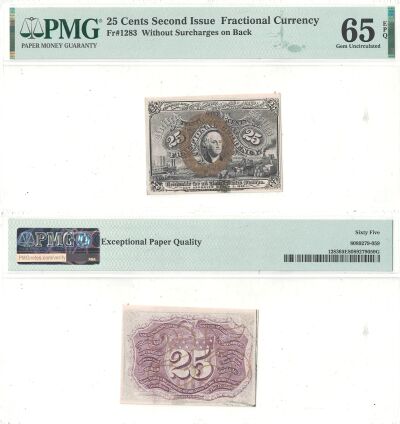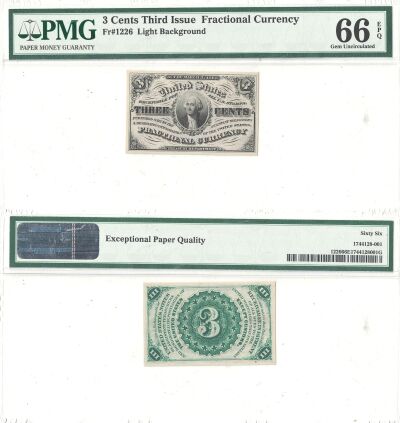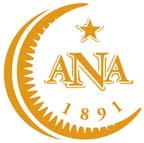Fractional Currency
Faced with severe hoarding of coinage during the Civil War, the Federal government was forced to issue small change paper money, known as "Fractional Currency" to alleviate the situation. Several different series of notes were issued between 1862 and 1876, all in denominations less than one dollar.
From the first issue of Postage Currency, so named because of the postage stamp designs, to the odd 3 Cent note (issued because the cost to mail a letter was 3c) and the unusual 15 Cent note, Fractional Currency is a fascinating and affordable way to collect early U.S. paper money. This field has enjoyed great popularity in recent years and continues to amaze generations of collectors.
- Found 15 items
 10c. 1st Issue. PCGS. Gem-66. PPQ. F-1242.$675.00
10c. 1st Issue. PCGS. Gem-66. PPQ. F-1242.$675.00Plain Edges. With Monogram. A bright note with a fresh appearance and well centered on both sides.
Item #245530 (1 / 15) 10c. 2nd Issue. PMG. Unc-62. EPQ. F-1249.$495.00
10c. 2nd Issue. PMG. Unc-62. EPQ. F-1249.$495.00Fiber paper with surcharges '18-63 & T-1'. A bright and fresh appearance. Very scarce and desirable.
Item #237229 (2 / 15) 10c. 3rd Issue. PCGS. Gem-66. PPQ. F-1255.$450.00
10c. 3rd Issue. PCGS. Gem-66. PPQ. F-1255.$450.00Green Reverse. Rich color, bright paper, and great borders provide excellent eye appeal.
Item #244081 (3 / 15) 10c. 4th Issue. PCGS. Gem-65. PPQ. F-1257.$375.00
10c. 4th Issue. PCGS. Gem-65. PPQ. F-1257.$375.00A vignette of Ms. Liberty with strong color and premium paper.
Item #221897 (4 / 15) 10c. 5th Issue. PMG. Superb-67. EPQ. F-1266.$625.00
10c. 5th Issue. PMG. Superb-67. EPQ. F-1266.$625.00Short, Thick Key. Portrait of William Meredith, Secretary of the Treasury. Very well balanced margins with great color, bright paper, and plenty of security threads.
Item #251154 (5 / 15) 15c. 4th Issue. PMG. VF-30. F-1268.$495.00
15c. 4th Issue. PMG. VF-30. F-1268.$495.00Unwatermarked. Pink Fibers. Light even wear and solid for the grade. The 'key' variety in the type.
Item #245533 (6 / 15) 25c. 2nd Issue. PMG. Gem-65. EPQ. F-1283.$649.00
25c. 2nd Issue. PMG. Gem-65. EPQ. F-1283.$649.00Without Surcharges on Back. A pleasing example that exhibits strong color with a little black over inking. Bronzing appears fresh and premium paper is bright.
Item #247959 (7 / 15) 25c. 3rd Issue. PMG. Ch Unc-64. EPQ. F-1291.$399.00
25c. 3rd Issue. PMG. Ch Unc-64. EPQ. F-1291.$399.00Red Reverse. A lovely note with strong color, premium paper, and well balanced margins on both sides.
Item #251307 (8 / 15) 25c. 3rd Issue. PMG. Gem-65. EPQ. F-1294.$449.00
25c. 3rd Issue. PMG. Gem-65. EPQ. F-1294.$449.00Portrait of William Fessenden, Secretary of the Treasury under Lincoln. Very attractive with nice bronzing, strong color, and bright premium paper.
Item #250170 (9 / 15) 3c. 3rd Issue. PMG. Gem-66. EPQ. F-1226.$599.00
3c. 3rd Issue. PMG. Gem-66. EPQ. F-1226.$599.00Light Background. Nicely balanced margins, strong color, and bright premium paper.
Item #250752 (10 / 15) 50c. 1st Issue. PCGS. Very Ch-64. F-1312.$315.00
50c. 1st Issue. PCGS. Very Ch-64. F-1312.$315.00Straight Edges. With Monogram. An attractive example with strong color and bright paper.
Item #251089 (11 / 15) 50c. 1st Issue. PMG. Gem-65. EPQ. F-1312.$675.00
50c. 1st Issue. PMG. Gem-65. EPQ. F-1312.$675.00Straight Edges. With Monogram. An attractive example with nice borders, vibrant color and premium paper.
Item #250302 (12 / 15) 50c. 3rd Issue. PMG. AU-55. EPQ. F-1345.$359.00
50c. 3rd Issue. PMG. AU-55. EPQ. F-1345.$359.00Red Back. "1" on Front. Fully margined with bright premium paper, strong color, and nice bronzing.
Item #250606 (13 / 15) 50c. 3rd Issue. PMG. Ch AU-58. EPQ. F-1334.$269.00
50c. 3rd Issue. PMG. Ch AU-58. EPQ. F-1334.$269.00Green Back. "a" on Front. A premium note that displays strong color and bronzing. The paper is bright and margins are full.
Item #250924 (14 / 15) 50c. 3rd Issue. PMG. Ch AU-58. F-1366.$329.00
50c. 3rd Issue. PMG. Ch AU-58. F-1366.$329.00Justice. A pleasing note with strong inks, bright paper, and solid bronzing.
Item #250915 (15 / 15)- 15 items found















